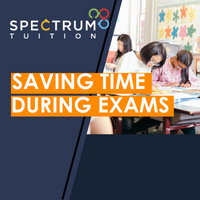The Victorian Selective Schools Exams will be taking place this weekend. Thousands of students across the state will be sitting this exam in an attempt to gain a competitive place in the Selective School of their choice. The exams are challenging and extremely fast paced; students are expected to produce essays and narratives in 15 minutes and sit 4 30-minute tests, each of which is comprised of up to 60 questions. In such a situation, the ability to manage one’s time becomes absolutely vital. So, today, I offer 4 tips for managing your time during high-pressure exams.
1. Prioritise
When in an exam, you have to use your time as effectively as possible. There’s no point spending excessive amounts of time on one particularly difficult question if it means missing out on getting easier points elsewhere. The important thing is to think how many marks you can get on the exam, and how many minutes you have. Then, you can work out how much time you can afford to give to each question. If you find that a low scoring question is taking you longer than you can afford, it is often a good idea to skip it and come back to it later.
2. Keep An Eye On The Clock
Don’t let time get away from you. Whether you are answering multiple choice questions or writing an essay under exam conditions, you should always be aware on how much time you have to dedicate to each task. You should know when it’s OK to keep working on a particular section and when it’s time to cut your losses and move on to the next task. If possible, bring your own watch to the exam so you can easily keep track of time.
3. Make Educated Guesses
In the multiple choice sections of the Selective Schools Exam, it is likely that some students might run out of time to answer all of the questions properly. In this case, with time running out, it is absolutely appropriate to guess. If you don’t put an answer, you have no chance of getting it right; even if you take a random guess, your odds are increased. The key, however, to making clever guesses is to try to narrow your odds as much as possible. Even if you don’t have time to figure out the correct answer, you should at least be able to eliminate some clearly incorrect answers. If you narrow it down to 2 possible solutions, your odds of guessing correctly rises from 20% to 50%.
4. Approximate When Necessary
Let’s say you’re in a multiple choice maths exam. You only have a few minutes left and you still have a page of questions that look like this.
4.02 x 6.99 =
A. 28.0998
B. 30.012
C. 24. 332
D. 45.095
E. None of these
Obviously, if you have time, it’s best to calculate the correct answer the proper way. However, if you’re under a strict time limit, you may be able to take a good guess by approximating. Instead of multiplying 4.02 by 6.99, round these numbers to 4 and 7. 4 times 7 is 28, so the most likely answer will be A. While this may not be the best idea in all situations, approximations can often get you out of tricky situations when the clock is ticking.
If you are sitting a Selective Schools Exam this weekend, I wish you all the best and hope your hard work pays off!


